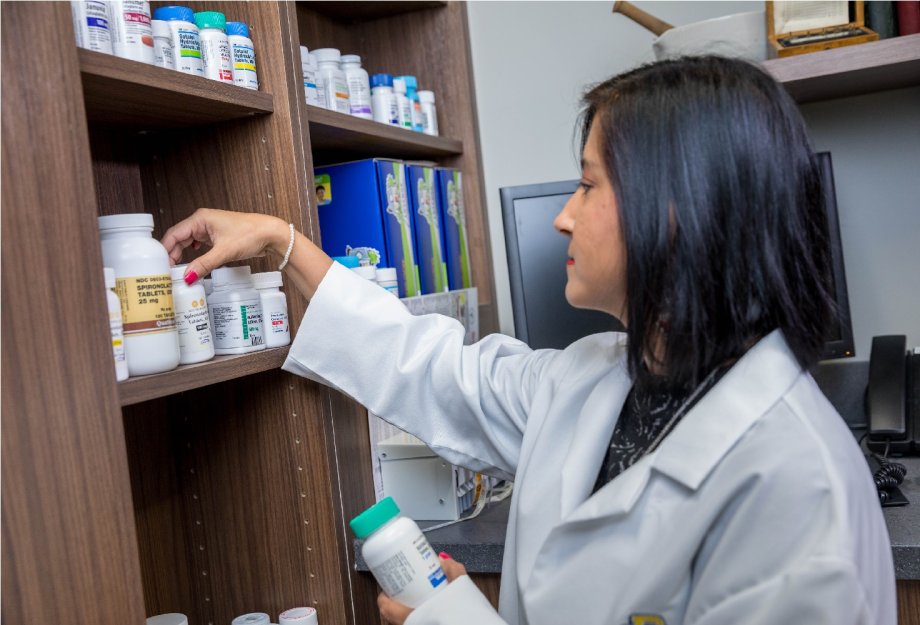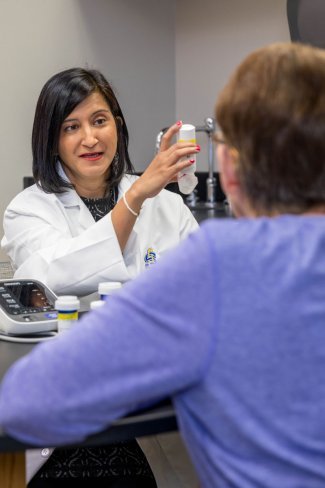
Investigators from the College of Pharmacy and Allied Health Professions at South Dakota State University are engaged in a five-year project, prompted by a call-to-action from the Centers for Disease Control and Prevention to develop solutions to improve the care of South Dakotans with diabetes, heart disease, and stroke.
According to the team’s annual report, year four was a year of “continued implementation and evaluation. More programs were expanded and launched, quality improvement continued throughout the year, and evaluation of data collected throughout implementation began.”

During the first year, the project team, led by Dr. Sharrel Pinto, interviewed South Dakota patients, practitioners, and payers and found that more information on the role of the pharmacist and the positive effect of pharmacist services like medication therapy management is needed. In year two, the project team expanded as they made strategic plans to recruit more participants and begin development of educational materials. And in year three, implementation efforts began and continued into year four.
In year four, the three workgroups saw their efforts begin to overlap. The project team chose to recombine the workgroups and “continued to strategize ways to facilitate communication and relationships between patients, practitioners, and payers, relationships which are imperative to the success of this project.” Dr. Christopher Robbins, who has background in health outcomes research and data evaluation, was also added to the project team.
The “Your Pharmacist Knows” campaign, which saw great success in year three, ran again in year four. The 30-second commercial aired once again, and a newspaper advertisement ran in 123 South Dakota newspapers, reaching 61 of South Dakota’s 66 counties.
A survey was conducted to assess the impact of the patient awareness campaign. Overall, results of the survey indicated that “the campaign can positively influence health behavior regarding pharmacy services in South Dakota through knowledge, attitude, norms, and perceived control constructs.” The project team has begun development of a manuscript reporting on the awareness campaign.
In year four, the project team also continued the success of providing American Pharmacist Association (APhA) training to South Dakota pharmacists. Four opportunities were offered over the course of the year with fourteen trainings completed. In year five, the project team plans to offer the trainings to pharmacists outside of collaborating sites in order to “improve access to MTM services in more pharmacies and strengthen relationships with pharmacies, ideally creating future opportunities to collaborate.”
Strategies developed in previous years initiated implementation in year three and continued into year four. Data from five collaborating sites was collected throughout this implementation and the project team began evaluation. Data included number of MTM services provided, types of services provided, when services were provided, where services were provides, methods of provision, and whether those providing services had received APhA training.
Efforts to increase enrollment in MTM services also continued. Tools like QR codes were implemented to increase awareness and ease of access to enrollment sites. Additionally, some strategies were developed to reach non-English-speaking populations. Efforts to expand to new sites also continued, including with the implementation of a pharmacist at a collaborating site. Manuscripts reporting and evaluating this data are in development.
Assessing the impact of these services is a priority of the project team. The project team has chosen health, behavior, and environment as three target areas for improvement and looks toward these areas to measure impact.
In order to help measure impact, the project team developed a “Patient Stories Reporting Tool." According to the team, “The tool is designed to help pharmacists document highlights of successful clinical impacts or interventions which they believe have contributed to improve patient outcomes and quality of life.”
After a successful patient encounter, pharmacists can fill out the PSRT in order to easily share the story of that patient encounter with other pharmacists, reporting on what worked and what might be areas of improvement. Through the trial run of the PSRT, cost reduction, medication synchronization, and continuous glucose monitoring were found to be important areas for improvement.
In year four, the project team continued their efforts to work closely with organizations that service the American Indian population of South Dakota. By conducting elicitation interviews with practitioners from an Urban Indian Health Center, the team worked to identify facilitators and barriers to the provision of care at UIHCs. Barriers included access to care, limited technological connectivity and challenges relating to adhering to treatment plans. A brief was developed and shared with the collaborating UIHC and a manuscript is in development.
As the project team wrapped up year four of the five-year project, attention began to shift toward looking forward to the conclusion of the project and beyond. The team provided some recommendations on what still needs to be done and will likely continue to need to be done over the coming years. Each of the 24 recommendations fell into one of three categories: “Expand the reach and support of resources,” “Expand and mature transdisciplinary relationships” and “Continue to grow confidence.”
The project team began sustainability efforts, facilitated by work and successful relationships developed in previous years. The team has found the MTM provision model to be effective and encourages the continued use of it. In order to ensure health plans support this work, evidence-based models need to continue to be used. Additionally, the team is working with one collaborating insurer to analyze the return on investment of services. Finally, the team is also collecting ECHO (economic, clinical, and humanistic outcomes) data. The data is trending positively, which will help to support contracting with third-party payers.
Overall, year four was a successful continuation of implementation efforts and start to data evaluation. The work done in year four began to show the fruits of the efforts of the project team and collaborators since day one of the project. The project team reflected that, “What began as a grass roots effort to move the needle on pharmacy services is rapidly evolving towards the need for expansion of these services to areas that are not yet being captured by this project and the inclusion of targeted interventions such as social determinants of health to minimize health disparities across patients receiving care at pharmacies across the state.”
In year five, the project team will continue to work on evaluation of data, continue quality improvement practices, and complete manuscripts and other methods of reporting so others can witness and learn from the successful work done through this project.
Learn more about The 1815 Project:
- Contact:
- Telephone number: 605-670-9658
Republishing
You may republish SDSU News Center articles for free, online or in print. Questions? Contact us at sdsu.news@sdstate.edu or 605-688-6161.

